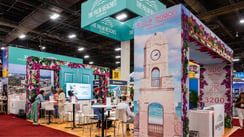The 4 E’s of Trade Shows
Planning your company’s trade show for the first time can be overwhelming, but successful planning and execution can yield rewarding results. The most important thing to remember is that a trade show goes beyond selling your product or service. It’s about people; the connection between the people staffing your booth and the people visiting your booth. It may be helpful to remember the 4 E’s as you embark on your first trade show planning and execution: educate, engage, empathize, and evolve. The 4 E’s are based on the research stated in the CEIR Industry Insights Series article titled It’s Not Your Father’s or Mother’s Trade Show Anymore – Engage with Caution.
Educate
Half the battle of a successful trade show is having an educated, passionate staff ready to solve potential clients’ problems with a product or service. Consider organizing a staff training session. Take time to go over your company’s goals for the trade show, such as capturing X number of leads or exposing X number of people to your brand. Spend some time during staff training to ensure that the staff are ready to answer frequently asked questions about your company’s product or service. It’s also helpful to go over staff roles for the booth so your staffers aren’t afraid to be experts in what they know, and rely on other staffers for areas they don’t know as well. Lastly, a critical aspect is to know the market that will be coming to the show and more importantly, how to engage with that market. Millennials make up a large portion of the job market today and are their own unique generation requiring a completely new engagement strategy apart from how one would engage with the generations before them.
Engage
A trade show is one of the only opportunities for your company to be in front of so many potential customers at one time. One of the most important things to remember as you prepare for your company’s trade show is that your company is there to help solve a problem that your potential clients have, not necessarily sell them your product or service on the spot. The first step is to get them into your booth. Utilizing tools such as experiential games is a great way to attract people to your booth, especially millennials. As a millennial I can attest that we are a generation that wants to experience. We would rather be drawn in with an immersive experience that utilizes some of the newest and coolest technology advancements instead of being presented with statistical information. Once you start the connection off with a fun, unique introduction, the second step is to begin building connections with the people who visit your booth.
Empathize
Empathy is the natural next step after engagement. Remember that all people don’t fit in the same mold, and everyone is at the trade show for a unique reason. Beyond a fun introduction to draw people into your booth, the next step is to create connection based on empathy. As millennials, we desire connection on a personal level so encourage your trade show staffers to ask questions, and more importantly, listen to the responses. With empathy comes trust, which millennials seek in the products or services they purchase. It’s often said that millennials choose brands that are socially and environmentally friendly. By finding out what is important to millennials during that initial conversation in a trade show booth can lead to a deeper understanding of millennials as a marketable generation. Before the conversation wraps up, make sure your staffers continue that connection with an action step, whether that is exchanging business cards, scanning their show badge, or sending them off with product information they are interested in.
Evolve
Lastly, it’s important to remember that as times change, generational preferences evolve, and with that comes the need for new strategies to relate to trade show goers. For instance, the baby boomer generation may go to trade shows to place orders with the same company they’ve remained loyal to for years. On the other hand, millennials are generally looking for a personal connection with a company and the newest and coolest products and services in the industry. But just as millennials have begun to outnumber baby boomers and Generation X in the workforce, Generation Z will begin outnumbering millennials and they’ll come to trade shows with their very own generational preferences.





